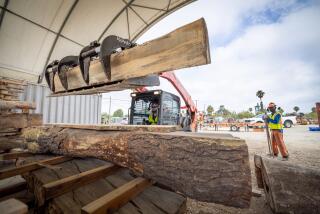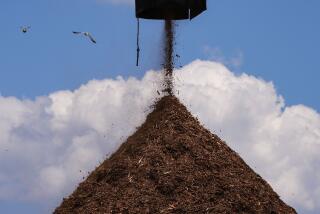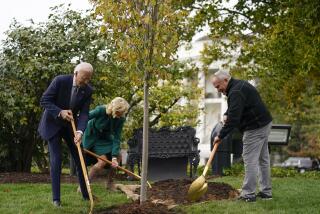Mistaking Trees for a Forest?
SPENCER MOUNTAIN, Tenn. — If many trees are cut down in a forest, but others are planted to take their place, is it still a forest?
Or is a forest something more elusive: a repository of varied life forms, a cradle for clear-running streams, a historical continuum where children and their fathers and grandfathers can sit atop old stumps, watch for squirrels and talk?
That’s the question posed here in central Tennessee, where giant timber-cutting machines shear native trees off Spencer Mountain like skin off a black bear.
Mathematically, clear-cutting tens of thousands of trees is not a problem. The South is growing more trees than it is cutting down. By mid-century, trees may well cover more ground than they do today.
The issue is that as the timber industry cuts the region’s slow-growing oaks, hickories and other hardwoods to feed the nation’s ravenous appetite for computer paper, chipboard and other consumer products, it is sowing a sterile substitute: vast pine tree plantations.
Many biologists dismiss these new forests as nothing more than agricultural fields planted with nonnative trees. A real forest, they argue, is something more messy, primal and elusive--a place to learn not just about nature and hunting but about the world of your ancestors.
Tennessee is emblematic of the transformation sweeping the South, which today produces more wood products than any single country on Earth.
The 13 Southern states account for nearly 60% of the nation’s wood output, almost four times the current volume of the once-mighty Pacific Northwest. The escalating timber market is altering landscapes from Georgia to Arkansas, turning oak forests, farm fields and marshes into man-made seas of planted pine.
The question of whether these pine stands are forests or farms is a new turn in a centuries-old quarrel over the role forests play in America.
Consider the 1890s feud between two pioneering giants in their fields--environmentalist John Muir and forester Gifford Pinchot--about the purpose of the first forest preserves. Muir envisioned them as preserves for wildness, containing “thousands of God’s wild blessings.” Pinchot saw them as more utilitarian, where trees would not only grow but provide valuable building materials.
The new forests are not the forests that Tennesseans recall from childhood.
The trees are mostly loblolly pine, grown in rows, mostly the same age, the same height and cut at the same time by giant machines. The loblolly stands are fertilized and managed and devoid of many native plants and animals.
Government and industry foresters say the plantations are highly productive and emulate many of the roles of natural tree stands. More efficient forests, they say, mean that more wilderness can remain unscathed. Timber companies contend that years of “high-grading” in old groves--harvesting the best and strongest trees--have weakened forests, leaving behind spindly stands.
“You end up with what a professor I had in school called ‘green junk,’” said Sharon Haines, International Paper manager of sustainable forestry.
Ecologists counter that given time and sunlight, a small oak will grow larger, and that even a crooked tree can hold a songbird’s nest.
Most tree farms produce a single species, the fast-sprouting loblolly, in place of a slower growing mixture of native Tennessee oaks, hickories and sycamores. The loblollies can be harvested by machine and replaced with seedlings in as little as 25 years, two to five times faster than the regrowth of a traditional forest.
The amount of Southern land devoted to pine plantations will increase 67% to 54 million acres--an area the size of Utah--by 2040, predicts a U.S. Forest Service report. Natural forests of all types will decline 17%, meanwhile, with the most dramatic conversion occurring in Tennessee, the report says.
Barry Graden, forestry development manager for Bowater Inc., one of Tennessee’s largest timber companies, is proud of his new forests.
He shows off a stand of young, green loblollies, saying they provide nesting habitat for quail, shelter for deer, wild turkeys and rabbits, easy foraging for hawks and eagles.
But Graden and other forest experts concede that when planted loblollies grow taller, the sunlight dims and creatures disperse.
“As the canopy closes on a planted pine stand, that diversity will drop off rather substantially,” said David Wear, coauthor of the recent Forest Service report.
The Forest Service report regards the growth of plantations as an important hedge against suburban sprawl, which the authors say is the single greatest threat to Southern forests.
Paul E. Davis, director of water pollution control at the Tennessee Department of Environment and Conservation, said pine plantations treat the land and water more gently than, say, a 100-store mall surrounded by acres of asphalt. “It’s good for clean water in Tennessee to see a viable forestry industry, because that keeps the land use from changing,” he said.
The conversion to plantations has been going on for half a century. But the process accelerated in the last two decades as Fortune 500 timber companies moved away from the Northwest to the friendlier regulatory atmosphere of the South. Most Southern forests are privately owned and immune from the environmental restrictions imposed on the federal forests of the West.
Unlike California, most Southern states do not require timber companies that cut trees on private land to draw up plans to protect wildlife and water quality. Tennessee requires no notification before land is logged.
Nor is there a lone imperiled species, like the Northern spotted owl, which became the icon of the Northwest timber wars. No single forest creature has emerged to trigger federal endangered-species laws across the South. Nor can even a small number of Southern forests be called “primeval,” as in the West, since generations of Southern settlers cleared trees for farmland that in time were overgrown by new forests.
Today’s pine plantations flourish on abandoned farms in southern Appalachia and the Mississippi Valley, in Florida grasslands, Alabama river valleys and in the coastal lowlands of the Carolinas.
Around Spencer Mountain and elsewhere in rural Van Buren County, neon green swaths of nonnative loblollies intermingle with the brown bark of hardwoods. Thin bands of trees called beauty strips still line the roads, masking the clear-cuts beyond.
“They hurt this mountain out here. It ain’t nothing but a pile of brush,” said William Bouldin, 84, whose father taught him to cut trees one at a time.
Van Buren County has lost more native forest than all six neighboring counties on the Cumberland Plateau, according to a new study commissioned by the U.S. Environmental Protection Agency and the U.S. Fish and Wildlife Service.
Hardwood clear-cuts in the county were immense--averaging 186 acres, 50% beyond the timber industry’s own recommended limit for clear-cuts, said the director of the study, Jonathan P. Evans, associate biology professor at the University of the South in Sewanee, Tenn. The study focused on the plateau because it is part of a region valued for its biological diversity.
The best example of the area’s natural treasures is Fall Creek Falls State Park, which features deep forested gorges, ancient bonsai-sized cedars and a 256-foot-high waterfall, the highest east of the Rockies.
Ecologists fear that soil runoff from clear-cutting is sullying the crystalline creeks that flow through the park and support fish, mussels and other aquatic creatures. After recent flooding, muddy runoff from treeless hillsides turned Fall Creek Lake the color of chocolate milk.
For botanists, a walk through a heavily cut hardwood forest becomes a hunt for clues that it still functions as a biological haven. Chris Bullington, a botanist with the Nature Conservancy of Tennessee who grew up on the plateau, says he sometimes can’t find a single rare flower or skittering salamander, and he wonders then if the forest has been cut too many times to be repaired. Then he spots a sign--an unusual white fringeless orchid, perhaps, sheltered by ferns--and he is reassured.
“Everybody’s been operating on the notion there’s plenty of trees. No one’s been keeping score,” Bullington said. “Now people are bumping into each other--’Oh, you’ve been cutting trees on the other side of the hill, and I’ve been cutting on this side.’”
Tennessee forester Ronald Measles grew up in the woods around Spencer Mountain, where his father took him hunting and taught him to tell red oaks and white oaks apart by the shape of their leaves. He did the same for his own son.
Only two years ago, oak forests surrounded the small office on Spencer Mountain where Measles works as a technician for the state Division of Forestry. Today that office overlooks a clear-cut field.
Not only have the old forests vanished, but so have the small family-owned sawmills, and the freedom of children to hike and hunt right down the road.
The tiny county, population 5,200, is so impoverished that it is only now building its first sewage treatment plant. It still has not enjoyed an economic boom from the recent logging. Machines called “feller-bunchers” scoop up piles of logs, much like the bright orange “Super-Axe-Hacker” that harvested Truffula Trees in Dr. Seuss’ “The Lorax.” As the timber companies stripped the hardwoods, few local residents were hired to help.
“They weren’t employing anyone in the community. They weren’t buying anything in the community,” said Van Buren County Executive Kelly Dishman.
Much of the clear-cut hardwood goes, not to small, traditional industries, but to chip mills such as International Paper’s Royal Blue mill in Caryville, Tenn. It produces around 200,000 tons of hardwood chips each year with a staff of seven. Most of those chips are used to make paper.
As chip mills proliferate, small manufacturers wonder where they will get their hardwoods. The Burroughs-Ross-Colville Co. in McMinnville has been crafting handles for axes and hammers since the 19th century. On an office shelf, one manager displays a hammer that appears to be Tennessee-made, but in fact has a handle made of foreign wood. That is perhaps the deepest fear: that not only are local hardwoods disappearing, but the replacement wood will come from overseas.
“It’s really changed, it sure has,” Ronald Measles said. “The kids worked in the woods, and cut timber. Now the timber’s gone. It probably won’t be back in our lifetime.”
More to Read
Sign up for Essential California
The most important California stories and recommendations in your inbox every morning.
You may occasionally receive promotional content from the Los Angeles Times.










